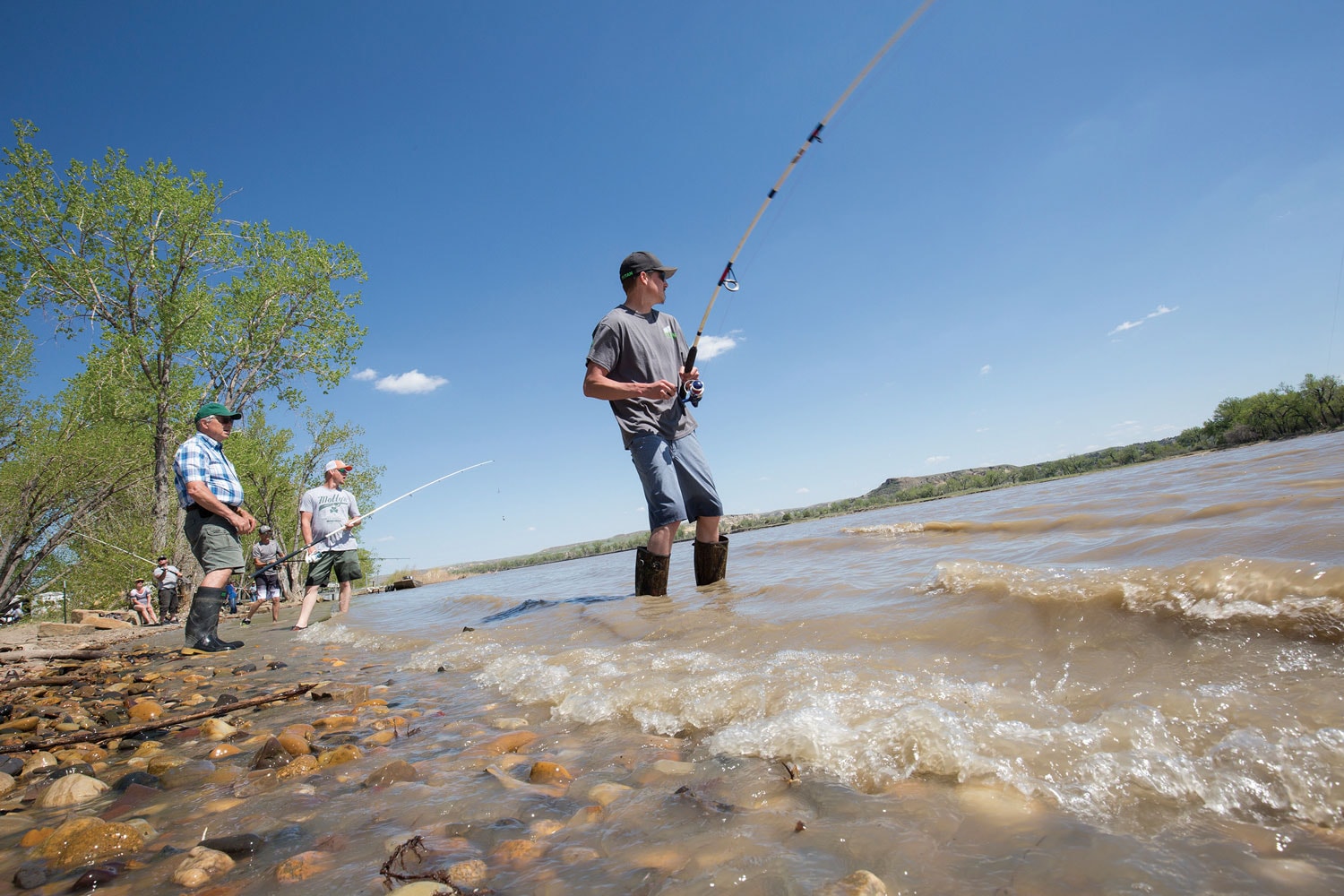
11 Jun Cow-Country Caviar
On the lower Yellowstone River, the precious eggs of a living dinosaur are converted into an international delicacy that helps pay for playgrounds and museums
Barbara Garrison lifts her shirt to reveal a squall of angry red welts on her abdomen. She blushes, but also beams with pride as she describes how she earned the abrasions. “At first, I thought I had snagged the bottom of the river,” says Garrison, a Miles City, Montana, native who now lives in Indiana. We were talking at the Intake Dam Fishing Access Site on the lower Yellowstone River, about 15 miles downstream of Glendive, Montana, and just a few miles from the North Dakota border. Garrison was one of several dozen anglers who were thigh-deep in the heavy water participating in various stages of fishing, catching, or recovering. “Then, my pole started bending and I could tell it was a fish. It felt like a big log. My brother told me to just stick my rod butt in my stomach and hold on.”
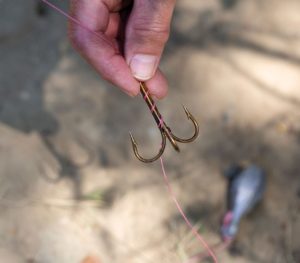
Paddlefish snaggers use large, weighted treble hooks to impale fish; the hooking trauma rarely causes permanent injury.
Garrison had connected with a paddlefish, the largest fish in Montana. The Yellowstone River, churning with runoff from the melting snowpack in the mountains around Yellowstone National Park, amplified the pull of the creature as it turned into the current and struggled against Garrison’s efforts to bring it to shore.
But Garrison prevailed. After a tortuous 20 minutes of tugging, reeling, and simply hanging on, she guided the 4-foot-long gunmetal-gray fish into knee-deep water, where her brother, Luke, received it. He held the restive fish, which he estimated at 50 pounds, by the base of its deeply forked tail. With his other hand, he grabbed the fish’s ludicrous snout. Biologists call this spatula-shaped appendage a “rostrum.” It serves as an aquatic stabilizer and food detector. But most people simply call it a paddle, and Luke held it tight so Garrison could pose in the water for a quick picture with her fish.
Then, the siblings removed the golf-ball-sized treble hook from the fish’s flank, and Luke guided it back into the current. After two unproductive flails, the paddlefish strokedits powerful tail and disappeared into the brown water.
“Holy shit, that was a riot!” yells Garrison, as she splashes to shore and the shade of cottonwood trees where her family had set up lawn chairs and a cooler. Back at their makeshift camp, she inspects her chafed abdomen and relives the experience. “They’re stronger than I expected. And that current is the real deal,” she says. “I cannot imagine what it’s like to tie into a 100-pounder!”
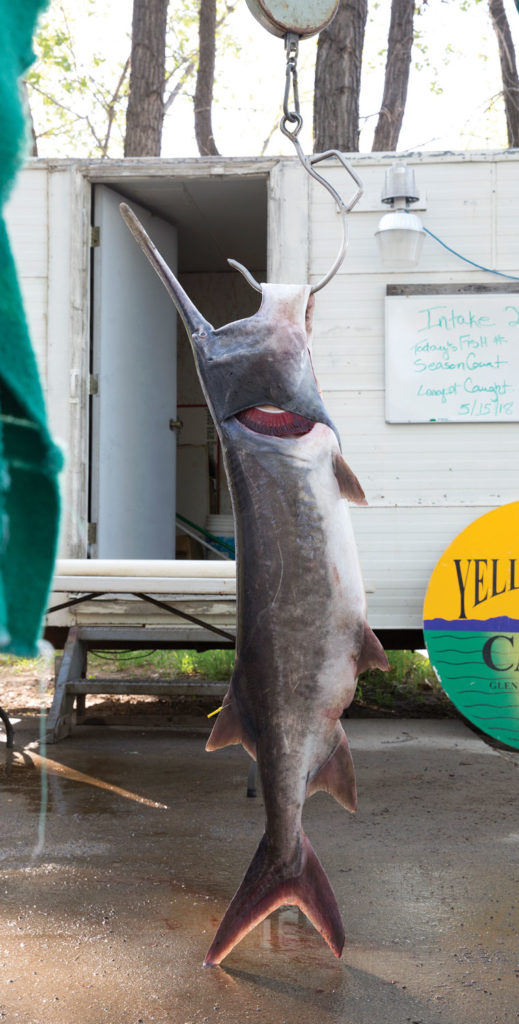
A harvested paddlefish waits to be filleted in the riverside processing center. Volunteers remove and preserve caviar from female fish.
The Garrisons were fishing the Yellowstone on one of the designated catch-and-release days for paddlefish, so they had to let their catch go. Had they been at Intake on a catch-and-keep day, they would have tagged the fish with a locking seal and been required to keep it. Then they would have had a choice to make: donate the eggs of a female fish in exchange for the butchering and vacuum-sealing of the meat, or process the fish themselves and keep or discard the eggs, called roe.
Tucked in the trees behind the Garrisons’ chairs is a converted camp trailer with volunteers who help the anglers that decide to donate the roe. Operated by the Glendive Chamber of Commerce and Agriculture, it’s the humble start of a culinary delicacy that converts Yellowstone River paddlefish eggs into caviar that ends up on the cut-crystal plates and silver spoons of gourmands from Manhattan to Tokyo.
An ancient native
Paddlefish are among the world’s most ancient extant species and are relatively unchanged from 70 million years ago, when they evolved in the warm, shallow sea that once covered what is now Montana. The earliest paddlefish shared space with duck-billed dinosaurs and carnivorous reptiles called Elasmosauruses, which looked like fanged, shell-less turtles.
At some point, the sea shrank and rivers drained the drying country. Dinosaurs disappeared. Paddlefish, along with other cartilaginous fish — like shovelnose sturgeon and their now-endangered cousins, the pallid sturgeon — used the heavy spring flow of the Missouri and Yellowstone rivers, along with smaller waterways like the Powder, Tongue, Milk, and Bighorn rivers, to reach upstream spawning areas. They require gravel shoals where their adhesive eggs can stick, nearby slack water where larval fish can mature, and a long stretch of free-flowing river that allows drifting juvenile paddlefish time to develop into strong swimmers and find the open-water plankton that sustains them.
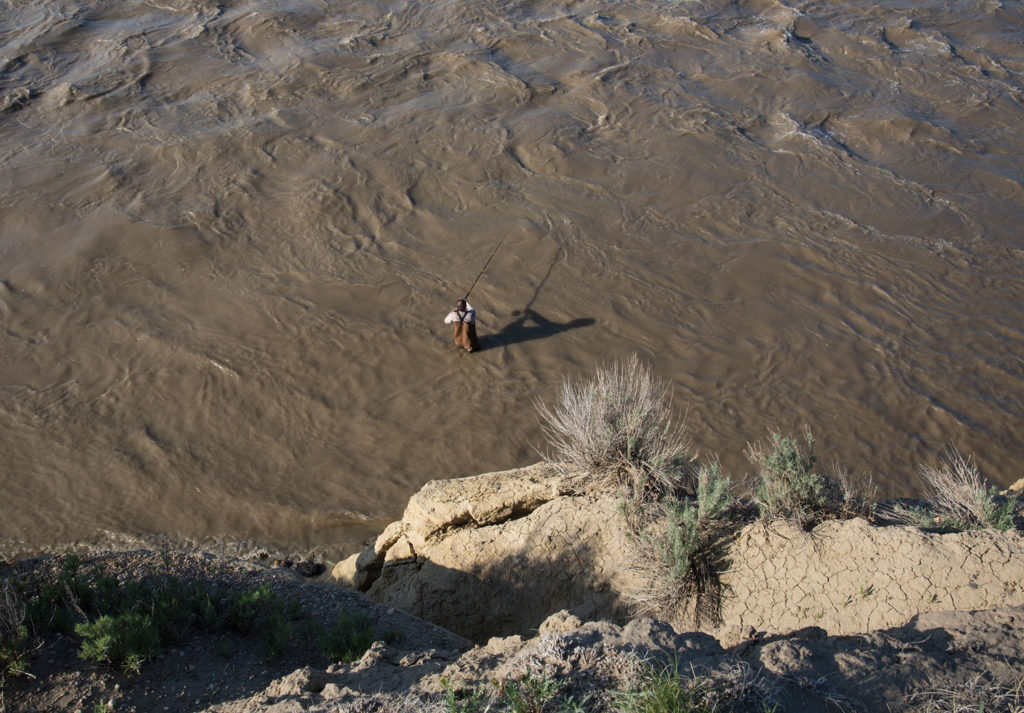
Because the river is at its highest flow during paddlefishing season, snaggers not only fight the fish, but also the swollen waters.
Paddlefish are vegetarians, raking in clouds of aquatic microorganisms that they filter through specialized gill plates in their gaping mouths. Their rostrums are specialized electroreceptors that help the fish find the prodigious amount of zooplankton required to grow to immense sizes. The state record is a 142.5-pounder snagged back in 1973 on the Missouri River. Fish in the 70- and 80-pound range are routinely snagged at Intake.
Because paddlefish won’t bite bait or swipe at lures, the only way to catch them is by sweeping large treble hooks through the water until they impale a fish, usually in its side but sometimes in its tail or rostrum. Snaggers use long rods, heavy line, and hooks that appear large enough to yank a pickup out of a snowdrift. When it’s done correctly — casting upstream and snapping the drifting hook with regular, aggressive jerks — paddlefish snagging makes participants look like they are dragging a river for a cadaver. When they successfully snag a fish, the fight is on, as Garrison discovered. Because the river is at its highest flow during paddlefishing season — the Yellowstone can churn at 40,000 cubic feet per second or more — snaggers fight not only the fish but the swollen river itself.
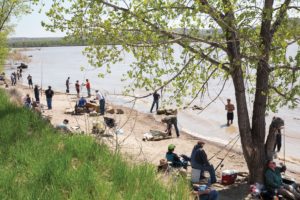
Intake Dam Fishing Access Site on the lower Yellowstone River is the epicenter for paddle- fish snagging.
The Yellowstone is often described as the nation’s longest free-flowing river, but that’s not entirely true, at least if you’re a fish. Intake Diversion Dam, namesake of the fishing access site, is a century-old rock weir that slows the river down and spills some of its water into canals that irrigate riverside fields of sugar beets, alfalfa, and corn.
The reason paddlefishing can be so good at Intake is that fish are forced to pause below the weir to figure out how to get to upstream spawning areas. Montana’s Yellowstone River annual paddlefish harvest quota is 1,000 fish for the season, which runs from May 1 to June 15, and in some years the total is achieved in a week or less. Eighty percent of the harvest takes place at Intake.
Complicated Harvest
Paddlefish snagging season at Intake used to be a circus, in every sense of the word. Until just a few years ago, you didn’t need a special permit to snag. Entire families descended on the river. Snagging parties drove in from out of state. When the river was up and the fish were running, you might have a half dozen paddlefish on lines at any given time. There was no harvest quota.
A big female paddlefish might hold 30 pounds of roe in her swollen belly. Most of the eggs, and much of the rest of the fish besides the meaty fillets, were routinely discarded in dumpsters at the fishing access site.
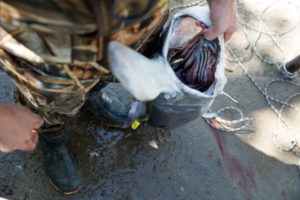
An angler handles a harvested fish.
“On a hot June afternoon, it smelled just like you’d think it would smell,” says Norm Unterseher, a volunteer who has helped anglers process their catch for years. Concerns were raised not only about the public nuisance of rotting paddlefish, but the waste of fish roe that in other parts of the world would be considered a delicacy.
Caviar, since the days of the Russian czars, has been shorthand for decadence, a food item so fine and rare that only discerning palates and high net-worthers might be worthy of its consumption. Its high demand and prices follow from its short supply, and the supply has been getting shorter since the blue-chip source of caviar, the Caspian Sea’s beluga sturgeon, became overharvested 50 years ago. The shortage of beluga turned the world’s attention to other sources, which is why a number civic boosters intervened in the Yellowstone paddlefish wastage.
What, they asked, if all that unloved roe could be collected, processed, and sold as domestic caviar? The 1989 Montana Legislature answered by approving a bill to allow the Glendive Chamber of Commerce to collect and sell paddlefish roe, returning the proceeds to riverside communities. In the 30 years since that legislation passed, the Paddlefish Caviar Grant Program has distributed more than $1 million in community grants, funding everything from Little League Baseball uniforms to homestead museum displays up and down the Yellowstone Valley.
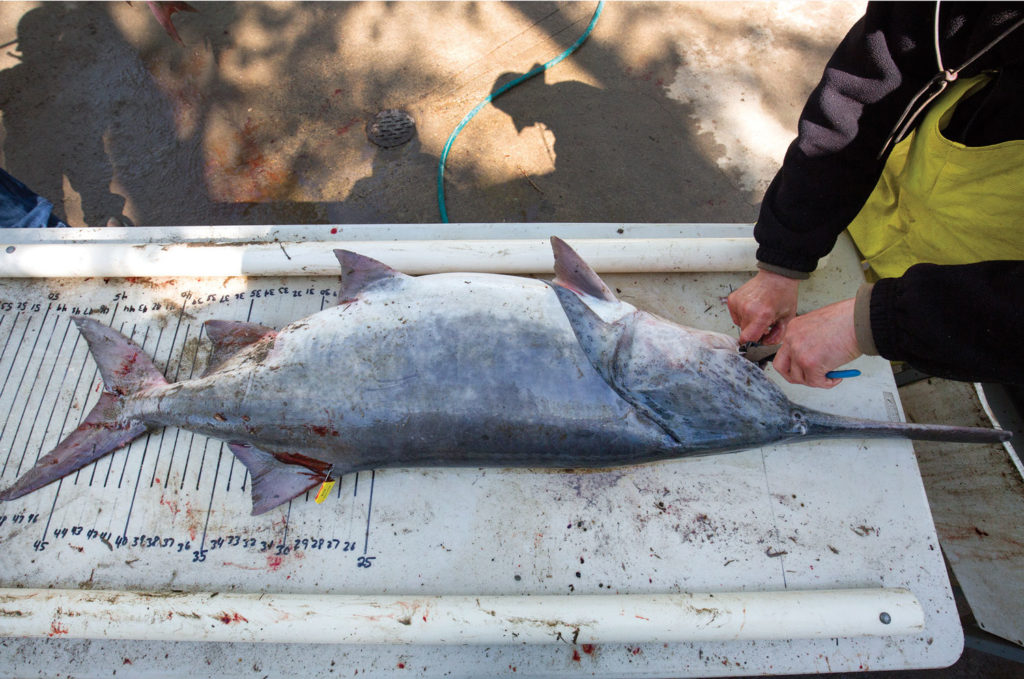
An angler handles a harvested fish.
It’s a sustainable, but potentially problematic, arrangement. The global history of caviar-producing fish is the history of black-market racketeering and white-market exploitation, which is why there’s abundant oversight of the Yellowstone caviar program. Thirty percent of annual roe revenue goes to the state’s department of Fish, Wildlife & Parks (FWP) to fund paddlefish research and management. The rest goes to the Chamber of Commerce’s grant program to benefit 15 counties along the lower Yellowstone.
“We’re committed to the program,” says Denny Malone, executive director of the Glendive Chamber of Commerce. Chamber-approved volunteers extract roe in the riverside trailer, then wash the eggs in a USDA-certified operation, and salt the ova to firm them and give them their distinctive briny taste. “But it’s been challenging,” he adds. “The global price of caviar has fluctuated with the recent introduction of sub-par Chinese caviar [from stocks of captive fish]. It’s a volatile market. Caviar is the second-most trafficked commodity in the world, after humans, but Yellowstone River caviar has a reputation as a consistent, sustainable product.”

Caviar is washed and cured on site.
Mike Backes is well aware of the tension. As the regional fisheries manager for FWP in Miles City, his job is to ensure that Yellowstone River paddlefish populations remain viable long after he retires. One of the tenets of America’s system of wildlife management, he says, is equitable, non-commercial distribution. “Any time you introduce market dynamics and commercialization, you can have problems with sustainability in wildlife populations,” says Backes. “This [caviar] program rides that edge. But as long as management of the fishery is first and foremost, and caviar collection is secondary, we think it’s a workable solution. We just don’t want commercialization to drive resource management.”
This year, as in the previous several years, the Yellowstone’s 1,000-fish quota will be strictly monitored and enforced. Once the catch-and-keep season ends, snaggers will likely have a limited catch-and-release season. But one variable that Backes and Malone are watching is a significant modification planned for the Intake weir. The rock barrier is being reconfigured, starting this spring, to improve passage for native fish, including paddlefish and pallid sturgeon. And while the project won’t be completed for several years, it may affect snagging success this season.
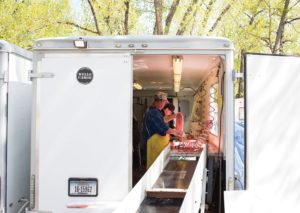
Inside the portable fish-processing center, volunteers fillet meat that will be returned to the angler.
“I’d guess fishing at Intake will be improved for the next two to three years, until the fish bypass is completed,” says Backes. “Then I’d expect a much more dispersed fishery, as paddlefish are better able to go upstream to the Powder River, the Tongue River, and even the Bighorn River. From a harvest-management standpoint, we’ll be starting over, but from a fish reproduction standpoint, I think it will be very good for the resource.”
How a more dispersed paddle fishery will affect egg collection is something that concerns Malone and his caviar effort. “We’ll adjust to the fish,” he says. “And hope the global market still has a place for our product.”
Has Malone tried Yellowstone River caviar? Yes, he says, though it’s not entirely to his taste. “This is cow country,” he says. “If you ask me to name a local delicacy, I’d say it’s a good Montana steak.”




No Comments